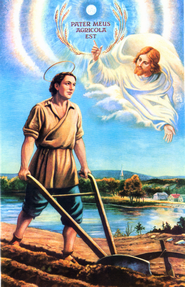Lives of the Saints
Our Models and Protectors
Spiritual Bouquet:
May 10

Saint Isidore of Madrid
Confessor
(† 1170)
Saint Isidore the Farmer, a perennially popular Saint in Spain, was born near Madrid of very poor but very Christian parents, who early inspired in him love for God and horror of sin. His education was accomplished entirely by the Holy Spirit who taught him, without books, the science of salvation.
He married a wife rich in virtue, Maria Torribia, and God blessed them with a son whom they brought up in the sentiments of their own piety. The child fell into a well, which is still shown in Madrid, and drowned; but when his parents prayed he might be returned to them, the water rose to ground level and brought up the child full of life and health. They promised then to separate, apparently out of gratitude to God, and to live in perpetual continence.
Saint Isidore's wife became a hermit like himself; Maria, too, performed miracles and merited after her death the name of Santa Maria de la Cabeza, meaning Head, because her head, conserved in a reliquary and carried in procession, has often brought down rain from heaven for the afflicted countryside. Her remains are honored by all of Spain by pilgrimages and processions at Torrelaguna, where they were transferred in 1615.
Saint Isidore himself was a day-laborer on a farm near Madrid, but every day found him at Mass in one of the churches of the city before he set out for his daily task. His employer desired to verify whether he was wasting time during his work, and one day saw two mysterious personages helping the holy worker to guide his plow; Isidore himself told him they were Angels. Afterwards the wealthy owner became still more convinced that piety was useful in all occupations. For not only did his worker bring back to life one of his horses, which he very much needed; when his daughter, too, died, she was resurrected by the Saint. A fountain of water which the Saint caused to surge up by striking the ground still exists.
Saint Isidore, though poor, shared all he had with the poor; and one day, when no provisions were left, his cupboard was found well furnished when still another beggar arrived.
Saint Isidore died some time after his wife; and forty years later his remains, which had been in extremely wet ground, were found incorrupt. They were taken into the Church of Saint Andrew and re-interred there; miracles have been countless, and celestial music has often been heard at his tomb. He has protected the city of Seville, making himself visible occasionally; and the kings of Spain themselves urged his canonization, which was carried out in 1622 by Pope Gregory XV.
Les Petits Bollandistes: Vies des Saints, by Msgr. Paul Guérin (Bloud et Barral: Paris, 1882), Vol. 5